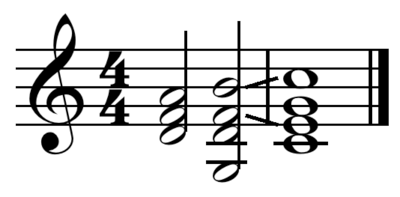Supertonic
In music, the supertonic is the second degree (![]()
The triad built on the supertonic note is called the supertonic chord. In Roman numeral analysis, the supertonic chord is typically symbolized by the Roman numeral "ii" in a major key, indicating that the chord is a minor chord (in C: D-F-A). In a minor key, it is indicated by "iio" if it is built on the a natural minor scale, indicating that the chord is a diminished chord (in C: D-F-A♭). Because it is a diminished chord, it usually appears in first inversion (iio6) so that no note dissonates with the bass note.
These chords may also appear as seventh chords: in major, as ii7 (in C: D-F-A-C), while in minor as iiø7 (in C: D-F-A♭-C) or rarely ii7. They are the second-most-common form of nondominant seventh chords.[2]
![]()
![]()
The supertonic chord normally functions as a predominant chord, a chord that naturally resolves to chord with dominant function. The supertonic chord lies a fifth above the V chord. Descending fifths are a strong basis for harmonic motion (see circle of fifths). The supertonic is one of the strongest predominants and approaches the V chord from above by descending fifth.


In major or minor, the major chord built on the lowered supertonic (♭![]()
The term supertonic may also refer to a relationship of musical keys. For example, relative to the key of C major, the key of D major (or D minor) is the supertonic.
In Riemannian theory, the supertonic is considered the subdominant parallel: Sp/T in major though sP/T in minor (A♭M).
Sources
- Benward & Saker (2003). Music: In Theory and Practice, Vol. I, p.32. Seventh Edition. ISBN 978-0-07-294262-0. "One step above the tonic."
- Kostka, Stefan; Payne, Dorothy (2004). Tonal Harmony (5th ed.). Boston: McGraw-Hill. p. 216. ISBN 0072852607. OCLC 51613969.
- Kitson, C. H. (2006). Elementary Harmony, p.43. ISBN 1-4067-9372-8.
